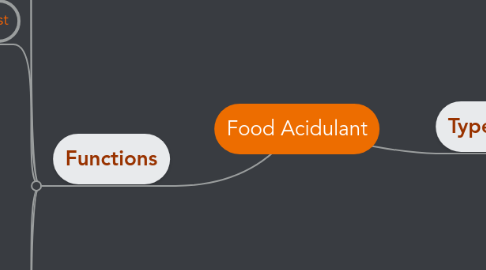
1. Functions
1.1. pH Control Agents
1.1.1. Important in : 1) obtain desired gel 2) leavening action of carbon dioxide 3) maintain the acidic pH & tartness in carbonated drinks 4) benefit for the products that use perservatives 5) maintain acidic fermentation processes by involving the buffering * Buffering: ability of weak acid/salt combination to control the amount of free hydrogen ions(provide protection from pH-dependent effects like colour or flavour changes.
1.2. Preservatives
1.2.1. Can stop growth or enhance the effectiveness of heat sterilization or the antimicrobial effect of solutes
1.2.2. Serve as antibrowning agents to maintain normal flavour, colour & texture
1.3. Chelating Agents/ Antioxidant Synergist
1.3.1. Metals such as iron,nickel, etc promote oxidative reactions by pruducing undesirable reactions such as discoloration, rancidity and instability of nutrients.
1.3.2. Chelation: Ability of acidulant to form ring structure with metal ions. Sequestration: Formation of stable, water-soluble chelate.
1.3.3. Functions
1.3.3.1. Retarding the enzymic browning of fruits & vege
1.3.3.2. Used as synergist for antioxidant(e.g. BHA & BHT) in the preservation of fats & oils, and in the food products that contain fatty compounds.
1.3.4. Example
1.3.4.1. Citric acid : strongest chelating agent
1.3.4.2. Lactic acid
1.3.4.3. Malic acid
1.3.4.4. Tartaric acid
1.4. Flavour Adjuncts
1.4.1. Functions
1.4.1.1. Modify or enhance food flavours
1.4.1.1.1. Enhancement of flavour requires combination of the flavour with appropriate acids
1.4.1.2. Add tartness required to balance the excessive sweetness ("brix acid ratio")
1.4.2. Different acid has different flavour profile
1.4.2.1. Acetic acid gives vinegar note. It would not enhance a delicately flavoured fruit beverage.
1.4.2.2. Citric acid gives a sharp clean bite but the acid taste dissipate quickly with citric acid
1.4.2.3. The acid taste lingers with fumaric acid
1.4.2.4. The acidity of malic acid builds slowly, but then lingers.
1.5. Control of Gelation & Coagulation
1.5.1. Play important role in the gelation of pectin and algins
1.5.2. E.g. for gelling high methoxyl pectin, the pH must be adjusted to 2.5 to 3.5.
1.5.3. Provide precise pH control in protein coagulation
1.5.3.1. Adding acid to cheese may shorten the production time and will result in uniform product consistency
2. Types of acid
2.1. Organic acid
2.1.1. Carboxylic acid
2.1.1.1. Monocarboxylic acid
2.1.1.1.1. Example: Acetic acid Proponoic acid Lactic acid
2.1.1.2. Dicarboxylic acid
2.1.1.2.1. Example: Malic acid Tartaric acid Adipic acid Fumaric acid
2.1.1.3. Tricarboxylic acid
2.1.1.3.1. Example: Citric acid
2.1.2. Phenolic acid
2.1.2.1. Example: Benzoic acid
2.1.3. Fatty acid
2.1.3.1. Example: Sorbic acid Caprylic acid Butyric acid
2.1.4. Lactones
2.1.4.1. Example: Ascorbic acid Gluconolactone
2.1.5. Amino acids
2.2. Inorganic acid
2.2.1. Example: Phosphoric acid(the only inorganic acid that can be used in food) Hydrochloric acid Sulfuric acid
